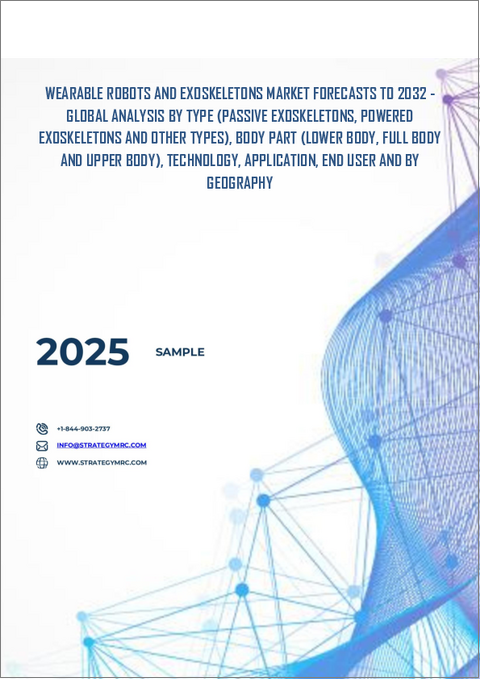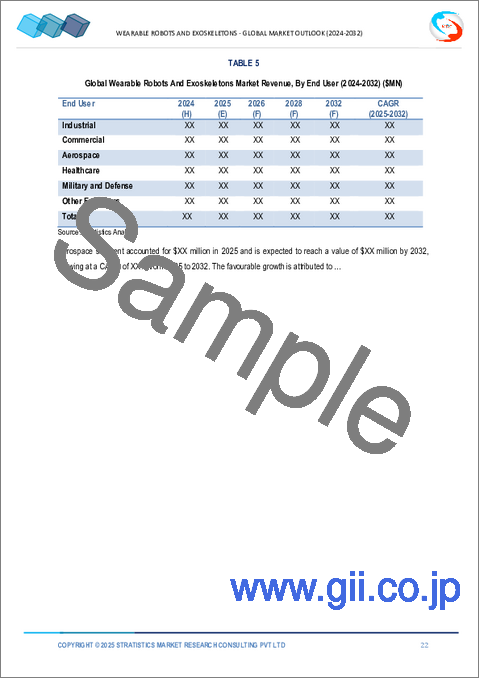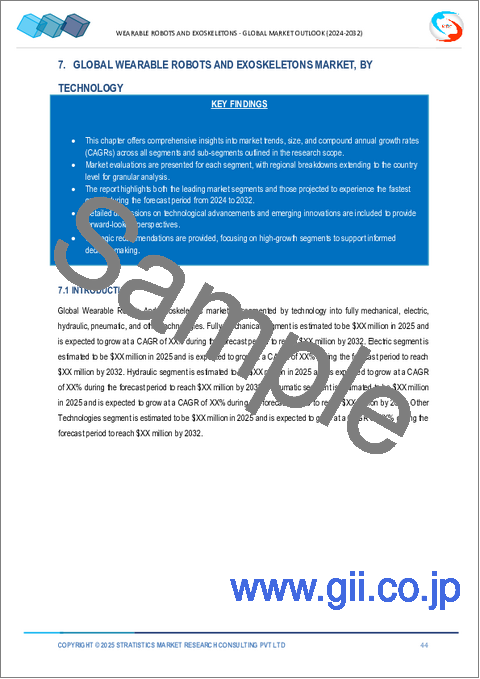|
|
市場調査レポート
商品コード
1494827
ウェアラブルロボット・外骨格の世界市場:分析 - タイプ別、身体部位別、技術別、用途別、エンドユーザー別、地域別、予測(~2030年)Wearable Robots and Exoskeletons Market Forecasts to 2030 - Global Analysis By Type (Passive Exoskeletons, Powered Exoskeletons and Other Types), Body Part (Lower Body, Full Body and Upper Body), Technology, Application, End User and By Geography |
||||||
カスタマイズ可能
|
|||||||
| ウェアラブルロボット・外骨格の世界市場:分析 - タイプ別、身体部位別、技術別、用途別、エンドユーザー別、地域別、予測(~2030年) |
|
出版日: 2024年06月06日
発行: Stratistics Market Research Consulting
ページ情報: 英文 200+ Pages
納期: 2~3営業日
|
全表示
- 概要
- 図表
- 目次
世界のウェアラブルロボット・外骨格の市場規模は、2024年に17億9,000万米ドルに達し、予測期間中にCAGR 44.4%で成長し、2030年までに162億3,000万米ドルに達すると予測されています。
ウェアラブルロボット・外骨格は、人間の能力を高めるために設計された機械装置です。特に筋力や持久力を必要とする作業において、身体的なサポートや支援を提供します。装着者の筋力や持久力を増強することで、これらのデバイスはヘルスケア、軍事、産業など様々な分野で応用されています。怪我や手術後のリハビリを補助したり、作業員が重いものを楽に持ち上げられるようにしたり、戦場での兵士のパフォーマンスを高めたりすることができます。
Maxon Motor AGの調査によると、世界中で毎日約1億8,500万人が車椅子を使用していると推定されています。Parkinson's Foundationの推計によると、米国におけるパーキンソン病患者数は、2020年には約93万人に達する可能性があり、2030年には120万人に達すると予想されています。
障害者の増加と高齢化
障害者の増加と高齢化は、ウェアラブルロボット・外骨格市場の重要な促進要因です。人口が高齢化するにつれて、モビリティを強化し、日常活動を支援するソリューションに対するニーズが高まっています。ウェアラブルロボット・外骨格はまさにそれを提供し、運動機能障害や加齢による制限を持つ個人の自立を支援し、生活の質を向上させる。これらの技術は、歩行、持ち上げ、長時間の立ち仕事など、他の方法では困難な作業を可能にします。
高コスト
ウェアラブルロボット・外骨格市場における高コストの抑制要因は、普及を妨げる重大な経済的障壁です。これらのデバイスの製造には複雑なエンジニアリングと高度な技術が必要なため、製造コストが高くなります。さらに、製造におけるスケールメリットが限られていることが、価格をさらに引き上げています。その結果、こうした革新的技術へのアクセスは、主に資金力のある産業界か富裕層に限られています。このコスト的制約は、大量市場浸透の可能性を妨げ、ヘルスケア、製造、防衛などさまざまな分野でこれらの機器が提供しうる利益を制限しています。
ヘルスケアとリハビリテーションのニーズの増加
ヘルスケアとリハビリテーションサービスへの需要の高まりが、ウェアラブルロボット・外骨格市場の成長を後押ししています。これらの革新的な技術は、身体的な障害や怪我を持つ人々に移動性の向上とサポートを提供し、それによって彼らの自立と生活の質を向上させる。高齢化人口が増加し、慢性疾患の発生率が上昇するにつれて、日常活動やリハビリプロセスを支援するソリューションに対するニーズが高まっています。ウェアラブルロボット・外骨格は、各ユーザーの特定のニーズに合わせてカスタマイズ可能なサポートを提供することでこの需要に応え、ヘルスケア施設やリハビリテーションセンターでの採用が世界的に急増しています。
限られた知識と指導
ウェアラブルロボット・外骨格市場における知識と指導の制限という脅威は、これらの高度なデバイスの適切な使用法やメンテナンスに関する不十分な理解や指導によってもたらされるリスクを指します。ユーザーはその能力や限界を十分に理解できず、誤用や事故につながる可能性があります。不十分な訓練や教育資源がこのリスクをさらに悪化させ、怪我や機器の破損につながる可能性があります。この脅威に対処するには、包括的なユーザー教育プログラムとメーカーによる明確な指示が必要です。
COVID-19の影響:
ウェアラブルロボット・外骨格市場は、COVID-19によってさまざまな影響を受けています。パンデミックによってヘルスケア環境におけるこれらの機器の価値が注目されるようになったとはいえ、世界なサプライチェーンと製造業務の混乱によって生産と納品に遅れが生じています。パンデミックがもたらした経済的不安の結果、産業・軍事用途のウェアラブルロボット・外骨格の需要も減少しています。しかし、遠隔医療や遠隔患者モニタリングの利用が拡大することで、ヘルスケア産業におけるウェアラブルロボット・外骨格の需要が高まり、市場に大きなチャンスが生まれると予想されています。
予測期間中、産業分野が最大になる見込み
ウェアラブルロボット・外骨格は、製造、物流、建設分野での利用が拡大していることから、予測期間中、産業分野が最大の市場シェアを占めると思われます。ウェアラブルロボット・外骨格は、産業作業の生産性と効率を高めると同時に、作業員の疲労と怪我のリスクを低減するために使用されています。製造部門における自動化とロボット工学の需要の高まりにより、市場は今後も拡大が見込まれます。企業が労働者の生産性と安全性の向上を目指す中、ウェアラブルロボット・外骨格は物流や建設分野でも普及が進むと予想されます。
予測期間中にCAGRが最も高くなると予測されるリハビリテーション分野
リハビリテーション分野は、予測期間中に最も速いCAGR成長が見込まれます。リハビリテーション分野は、市場で最も速い成長を遂げています。この背景には、障害者の増加と、病気や怪我からの回復を早める医療機器に対する需要の増加があります。リハビリテーション市場は、ウェアラブルロボット・外骨格が利用できるようになった結果、拡大しつつあります。今後もこの傾向は続くと予想されます。
最大のシェアを占める地域:
予測期間中、北米はウェアラブルロボット・外骨格の世界市場で最大のシェアを占めると予測されます。これは、患者の転帰と作業者の安全性を高めることができるデバイスに対する需要の高まりによるもので、ヘルスケアと産業部門が北米の成長の主な促進要因となっています。さらに、北米の市場成長は、この分野における重要なメーカーの存在と技術的進歩も後押ししています。
CAGRが最も高い地域:
アジア太平洋では、産業およびヘルスケア分野でこれらのデバイスの利用が拡大していることから、ウェアラブルロボット・外骨格の市場はCAGRが最も高くなると予測されています。アジア太平洋は高齢化が進み、障害者の割合が高いことから、市場の拡大が見込まれています。また、安価な労働力を利用できることや、最先端技術の導入を奨励する政府の支援策も、同地域の市場拡大に拍車をかけると予想されます。
目次
第1章 エグゼクティブサマリー
第2章 序文
- 概要
- ステークホルダー
- 調査範囲
- 調査手法
- データマイニング
- データ分析
- データ検証
- 調査アプローチ
- 調査情報源
- 1次調査情報源
- 2次調査情報源
- 前提条件
第3章 市場動向分析
- 促進要因
- 抑制要因
- 機会
- 脅威
- 技術分析
- 用途分析
- エンドユーザー分析
- 新興市場
- COVID-19の影響
第4章 ポーターのファイブフォース分析
- 供給企業の交渉力
- 買い手の交渉力
- 代替品の脅威
- 新規参入業者の脅威
- 競争企業間の敵対関係
第5章 世界のウェアラブルロボット・外骨格市場:タイプ別
- パッシブ外骨格
- パワード外骨格
- その他のタイプ
第6章 世界のウェアラブルロボット・外骨格市場:身体部位別
- 下半身
- 全身
- 上半身
第7章 世界のウェアラブルロボット・外骨格市場:技術別
- 完全機械式
- 電気式
- 油圧式
- 空気圧
- その他の技術
第8章 世界のウェアラブルロボット・外骨格市場:用途別
- 補助
- スポーツ
- リハビリテーション
- ボディパーツサポート
- その他の用途
第9章 世界のウェアラブルロボット・外骨格市場:エンドユーザー別
- 産業
- 商業
- 航空宇宙
- ヘルスケア
- 軍事・防衛
- その他のエンドユーザー
第10章 世界のウェアラブルロボット・外骨格市場:地域別
- 北米
- 米国
- カナダ
- メキシコ
- 欧州
- ドイツ
- 英国
- イタリア
- フランス
- スペイン
- その他の欧州
- アジア太平洋
- 日本
- 中国
- インド
- オーストラリア
- ニュージーランド
- 韓国
- その他のアジア太平洋
- 南米
- アルゼンチン
- ブラジル
- チリ
- その他の南米
- 中東・アフリカ
- サウジアラビア
- アラブ首長国連邦
- カタール
- 南アフリカ
- その他の中東・アフリカ
第11章 主な発展
- 契約、パートナーシップ、コラボレーション、合弁事業
- 買収と合併
- 新製品発売
- 事業拡大
- その他の主要戦略
第12章 企業プロファイリング
- ATOUN Inc
- Bionik Laboratories Corp.
- B-Temia Inc.
- Cyberdyne Inc
- Daiya Industry Co., Ltd.
- Ekso Bionics Holdings, Inc.
- Focal Meditech BV
- Honda Motor Co. Ltd
- Lockheed Martin Corporation
- Mitsubishi Heavy Industries, Ltd.
- Myomo Inc.
- P&S Mechanics Co. Ltd.
- Parker Hannifin Corporation
- ReWalk Robotics Ltd.
- Rex Bionics Pty Ltd.
- Sarcos Corporation
- Technaid S
- Wearable Robotics Srl
List of Tables
- Table 1 Global Wearable Robots And Exoskeletons Market Outlook, By Region (2022-2030) ($MN)
- Table 2 Global Wearable Robots And Exoskeletons Market Outlook, By Type (2022-2030) ($MN)
- Table 3 Global Wearable Robots And Exoskeletons Market Outlook, By Passive Exoskeletons (2022-2030) ($MN)
- Table 4 Global Wearable Robots And Exoskeletons Market Outlook, By Powered Exoskeletons (2022-2030) ($MN)
- Table 5 Global Wearable Robots And Exoskeletons Market Outlook, By Other Types (2022-2030) ($MN)
- Table 6 Global Wearable Robots And Exoskeletons Market Outlook, By Body Part (2022-2030) ($MN)
- Table 7 Global Wearable Robots And Exoskeletons Market Outlook, By Lower Body (2022-2030) ($MN)
- Table 8 Global Wearable Robots And Exoskeletons Market Outlook, By Full Body (2022-2030) ($MN)
- Table 9 Global Wearable Robots And Exoskeletons Market Outlook, By Upper Body (2022-2030) ($MN)
- Table 10 Global Wearable Robots And Exoskeletons Market Outlook, By Technology (2022-2030) ($MN)
- Table 11 Global Wearable Robots And Exoskeletons Market Outlook, By Fully Mechanical (2022-2030) ($MN)
- Table 12 Global Wearable Robots And Exoskeletons Market Outlook, By Electric (2022-2030) ($MN)
- Table 13 Global Wearable Robots And Exoskeletons Market Outlook, By Hydraulic (2022-2030) ($MN)
- Table 14 Global Wearable Robots And Exoskeletons Market Outlook, By Pneumatic (2022-2030) ($MN)
- Table 15 Global Wearable Robots And Exoskeletons Market Outlook, By Other Technologies (2022-2030) ($MN)
- Table 16 Global Wearable Robots And Exoskeletons Market Outlook, By Application (2022-2030) ($MN)
- Table 17 Global Wearable Robots And Exoskeletons Market Outlook, By Assistive (2022-2030) ($MN)
- Table 18 Global Wearable Robots And Exoskeletons Market Outlook, By Sports (2022-2030) ($MN)
- Table 19 Global Wearable Robots And Exoskeletons Market Outlook, By Rehabilitation (2022-2030) ($MN)
- Table 20 Global Wearable Robots And Exoskeletons Market Outlook, By Body Parts Support (2022-2030) ($MN)
- Table 21 Global Wearable Robots And Exoskeletons Market Outlook, By Other Applications (2022-2030) ($MN)
- Table 22 Global Wearable Robots And Exoskeletons Market Outlook, By End User (2022-2030) ($MN)
- Table 23 Global Wearable Robots And Exoskeletons Market Outlook, By Industrial (2022-2030) ($MN)
- Table 24 Global Wearable Robots And Exoskeletons Market Outlook, By Commercial (2022-2030) ($MN)
- Table 25 Global Wearable Robots And Exoskeletons Market Outlook, By Aerospace (2022-2030) ($MN)
- Table 26 Global Wearable Robots And Exoskeletons Market Outlook, By Healthcare (2022-2030) ($MN)
- Table 27 Global Wearable Robots And Exoskeletons Market Outlook, By Military and Defense (2022-2030) ($MN)
- Table 28 Global Wearable Robots And Exoskeletons Market Outlook, By Other End Users (2022-2030) ($MN)
Note: Tables for North America, Europe, APAC, South America, and Middle East & Africa Regions are also represented in the same manner as above.
According to Stratistics MRC, the Global Wearable Robots And Exoskeletons Market is accounted for $1.79 billion in 2024 and is expected to reach $16.23 billion by 2030 growing at a CAGR of 44.4% during the forecast period. Wearable robots and exoskeletons are mechanical devices designed to enhance human capabilities. They provide physical support and assistance, particularly in tasks requiring strength or endurance. By augmenting the wearer's strength and endurance, these devices find applications in various fields, including healthcare, military, and industry. They can aid in rehabilitation after injury or surgery, enable workers to lift heavy objects with ease, and enhance soldiers' performance on the battlefield.
According to a study by Maxon Motor AG, the company estimated that approximately 185 million people use a wheelchair daily worldwide. According to the Parkinson's Foundation estimates, the number of people in the United States with Parkinson's disease may be around 930,000 in 2020, and it is expected to reach 1,200,000 by 2030.
Market Dynamics:
Driver:
Increasing prevalence of disabilities and an aging population
The increasing prevalence of disabilities and an aging population are significant drivers in the wearable robots and exoskeletons market. As populations age, there's a growing need for solutions that enhance mobility and provide assistance in daily activities. Wearable robots and exoskeletons offer precisely that, aiding individuals with mobility impairments or age-related limitations to maintain independence and improve quality of life. These technologies enable users to perform tasks they might otherwise struggle with, such as walking, lifting, or standing for extended periods of time.
Restraint:
High cost
High cost restraint in the wearable robots and exoskeletons market is the significant financial barrier hindering widespread adoption. The intricate engineering and advanced technology involved in creating these devices contribute to their high production costs. Additionally, limited economies of scale in manufacturing further inflate prices. As a result, accessibility to these transformative technologies is restricted, primarily to well-funded industries or affluent individuals. This cost constraint impedes the potential for mass-market penetration and limits the benefits these devices could offer in various fields, including healthcare, manufacturing, and defense.
Opportunity:
Increase in the need for healthcare and rehabilitation
The rise in demand for healthcare and rehabilitation services has propelled the growth of the wearable robots and exoskeletons market. These innovative technologies offer enhanced mobility and support for individuals with physical impairments or injuries, thereby increasing their independence and quality of life. As the aging population grows and the incidence of chronic conditions rises, there's a heightened need for solutions that can assist in daily activities and rehabilitation processes. Wearable robots and exoskeletons cater to this demand by providing customizable support tailored to each user's specific needs, leading to a surge in their adoption across healthcare facilities and rehabilitation centers globally. This
Threat:
Limited knowledge and instruction
The threat of limited knowledge and instruction in the wearable robots and exoskeletons market refers to the risk posed by inadequate understanding or guidance regarding the proper usage and maintenance of these advanced devices. Users may not fully comprehend their capabilities or limitations, leading to misuse or accidents. Insufficient training and educational resources further exacerbate this risk, potentially resulting in injuries or damage to the equipment. Addressing this threat requires comprehensive user education programs and clear instructions provided by manufacturers.
Covid-19 Impact:
The Wearable robot and exoskeleton Market has been impacted by COVID-19 in a variety of ways. Even though the pandemic has brought attention to the value of these devices in healthcare settings, delays in production and delivery have resulted from the disruption of global supply chains and manufacturing operations. The demand for wearable robots and exoskeletons in industrial and military applications has also decreased as a result of the economic uncertainty brought on by the pandemic. However, it is anticipated that the growing use of telemedicine and remote patient monitoring will fuel demand for wearable robots and exoskeletons in the healthcare industry, creating a sizable opportunity for the market.
The industrial segment is expected to be the largest during the forecast period
The industrial sector will hold the largest market share for wearable robots and exoskeletons during the forecast period as a result of the growing use of these tools in the manufacturing, logistics, and construction sectors. Wearable robots and exoskeletons have been used to increase the productivity and efficiency of industrial operations while lowering worker fatigue and injury risks. Due to the growing demand for automation and robotics in the manufacturing sector, the market is anticipated to continue expanding. As businesses look to increase worker productivity and safety, wearable robots and exoskeletons are also anticipated to become more common in the logistics and construction sectors.
The rehabilitation segment is expected to have the highest CAGR during the forecast period
The rehabilitation segment is anticipated to witness the fastest CAGR growth during the forecast period. The rehabilitation sector has experienced some of the fastest growth in the market. This is brought on by an increase in both the prevalence of disabilities and the demand for medical equipment that can speed up patients' recoveries from illnesses and injuries. The rehabilitation market is expanding as a result of the availability of wearable robots and exoskeletons that can offer patients with mobility impairments the much-needed assistance they require. In the years to come, this trend is anticipated to persist.
Region with largest share:
During the forecast period, North America is anticipated to account for the largest share of the global market for wearable robots and exoskeletons, due to the rising demand for devices that can enhance patient outcomes and worker safety, the healthcare and industrial sectors have been the main drivers of growth in North America. Moreover, the growth of the market in North America has also been aided by the presence of significant manufacturers and technological advancements in the area.
Region with highest CAGR:
Due to the growing use of these devices in the industrial and healthcare sectors in the region, Asia-Pacific is predicted to have the market for wearable robots and exoskeletons with the highest CAGR. The Asia-Pacific market is anticipated to expand as a result of the region's aging population and high prevalence of disabilities. The availability of inexpensive labor and supportive government initiatives to encourage the adoption of cutting-edge technologies are also anticipated to fuel market expansion in the area.
Key players in the market
Some of the key players in Wearable Robots And Exoskeletons market include ATOUN Inc, Bionik Laboratories Corp., B-Temia Inc., Cyberdyne Inc, Daiya Industry Co., Ltd., Ekso Bionics Holdings, Inc., Focal Meditech BV, Honda Motor Co. Ltd, Lockheed Martin Corporation, Mitsubishi Heavy Industries, Ltd., Myomo Inc., P&S Mechanics Co. Ltd., Parker Hannifin Corporation, ReWalk Robotics Ltd., Rex Bionics Pty Ltd., Sarcos Corporation, Technaid S and Wearable Robotics Srl.
Key Developments:
In May 2024, Japanese automaker Honda Motor Co said its subsidiary Honda R&D (India) Pvt Ltd has opened a new Solution R&D center in Bengaluru, Karnataka. Honda R&D (India) is the research and development arm for Honda's motorcycles and power products in India. The new R&D Center will incorporate advanced mobility technologies into electric vehicle development more quickly. It will also work on software and connected services through 'co-creating' open innovation by adopting technologies and ideas of R&D companies.
In March 2024, Sarcos Technology and Robotics Corporation ("Sarcos") (NASDAQ: STRC and STRCW) is pleased to announce that effective today, the company has changed its name to Palladyne AI Corp. (Palladyne AI). Effective April 8, 2024, the Company's ticker symbol will change from NASDAQ: STRC to NASDAQ: PDYN. The new name reflects the company's narrowed focus on commercializing the artificial intelligence and machine learning software that it has been developing since 2020.
Types Covered:
- Passive Exoskeletons
- Powered Exoskeletons
- Other Types
Body Parts Covered:
- Lower Body
- Full Body
- Upper Body
Technologies Covered:
- Fully Mechanical
- Electric
- Hydraulic
- Pneumatic
- Other Technologies
Applications Covered:
- Assistive
- Sports
- Rehabilitation
- Body Parts Support
- Other Applications
End Users Covered:
- Industrial
- Commercial
- Aerospace
- Healthcare
- Military and Defense
- Other End Users
Regions Covered:
- North America
- US
- Canada
- Mexico
- Europe
- Germany
- UK
- Italy
- France
- Spain
- Rest of Europe
- Asia Pacific
- Japan
- China
- India
- Australia
- New Zealand
- South Korea
- Rest of Asia Pacific
- South America
- Argentina
- Brazil
- Chile
- Rest of South America
- Middle East & Africa
- Saudi Arabia
- UAE
- Qatar
- South Africa
- Rest of Middle East & Africa
What our report offers:
- Market share assessments for the regional and country-level segments
- Strategic recommendations for the new entrants
- Covers Market data for the years 2022, 2023, 2024, 2026, and 2030
- Market Trends (Drivers, Constraints, Opportunities, Threats, Challenges, Investment Opportunities, and recommendations)
- Strategic recommendations in key business segments based on the market estimations
- Competitive landscaping mapping the key common trends
- Company profiling with detailed strategies, financials, and recent developments
- Supply chain trends mapping the latest technological advancements
Free Customization Offerings:
All the customers of this report will be entitled to receive one of the following free customization options:
- Company Profiling
- Comprehensive profiling of additional market players (up to 3)
- SWOT Analysis of key players (up to 3)
- Regional Segmentation
- Market estimations, Forecasts and CAGR of any prominent country as per the client's interest (Note: Depends on feasibility check)
- Competitive Benchmarking
- Benchmarking of key players based on product portfolio, geographical presence, and strategic alliances
Table of Contents
1 Executive Summary
2 Preface
- 2.1 Abstract
- 2.2 Stake Holders
- 2.3 Research Scope
- 2.4 Research Methodology
- 2.4.1 Data Mining
- 2.4.2 Data Analysis
- 2.4.3 Data Validation
- 2.4.4 Research Approach
- 2.5 Research Sources
- 2.5.1 Primary Research Sources
- 2.5.2 Secondary Research Sources
- 2.5.3 Assumptions
3 Market Trend Analysis
- 3.1 Introduction
- 3.2 Drivers
- 3.3 Restraints
- 3.4 Opportunities
- 3.5 Threats
- 3.6 Technology Analysis
- 3.7 Application Analysis
- 3.8 End User Analysis
- 3.9 Emerging Markets
- 3.10 Impact of Covid-19
4 Porters Five Force Analysis
- 4.1 Bargaining power of suppliers
- 4.2 Bargaining power of buyers
- 4.3 Threat of substitutes
- 4.4 Threat of new entrants
- 4.5 Competitive rivalry
5 Global Wearable Robots And Exoskeletons Market, By Type
- 5.1 Introduction
- 5.2 Passive Exoskeletons
- 5.3 Powered Exoskeletons
- 5.4 Other Types
6 Global Wearable Robots And Exoskeletons Market, By Body Part
- 6.1 Introduction
- 6.2 Lower Body
- 6.3 Full Body
- 6.4 Upper Body
7 Global Wearable Robots And Exoskeletons Market, By Technology
- 7.1 Introduction
- 7.2 Fully Mechanical
- 7.3 Electric
- 7.4 Hydraulic
- 7.5 Pneumatic
- 7.6 Other Technologies
8 Global Wearable Robots And Exoskeletons Market, By Application
- 8.1 Introduction
- 8.2 Assistive
- 8.3 Sports
- 8.4 Rehabilitation
- 8.5 Body Parts Support
- 8.6 Other Applications
9 Global Wearable Robots And Exoskeletons Market, By End User
- 9.1 Introduction
- 9.2 Industrial
- 9.3 Commercial
- 9.4 Aerospace
- 9.5 Healthcare
- 9.6 Military and Defense
- 9.7 Other End Users
10 Global Wearable Robots And Exoskeletons Market, By Geography
- 10.1 Introduction
- 10.2 North America
- 10.2.1 US
- 10.2.2 Canada
- 10.2.3 Mexico
- 10.3 Europe
- 10.3.1 Germany
- 10.3.2 UK
- 10.3.3 Italy
- 10.3.4 France
- 10.3.5 Spain
- 10.3.6 Rest of Europe
- 10.4 Asia Pacific
- 10.4.1 Japan
- 10.4.2 China
- 10.4.3 India
- 10.4.4 Australia
- 10.4.5 New Zealand
- 10.4.6 South Korea
- 10.4.7 Rest of Asia Pacific
- 10.5 South America
- 10.5.1 Argentina
- 10.5.2 Brazil
- 10.5.3 Chile
- 10.5.4 Rest of South America
- 10.6 Middle East & Africa
- 10.6.1 Saudi Arabia
- 10.6.2 UAE
- 10.6.3 Qatar
- 10.6.4 South Africa
- 10.6.5 Rest of Middle East & Africa
11 Key Developments
- 11.1 Agreements, Partnerships, Collaborations and Joint Ventures
- 11.2 Acquisitions & Mergers
- 11.3 New Product Launch
- 11.4 Expansions
- 11.5 Other Key Strategies
12 Company Profiling
- 12.1 ATOUN Inc
- 12.2 Bionik Laboratories Corp.
- 12.3 B-Temia Inc.
- 12.4 Cyberdyne Inc
- 12.5 Daiya Industry Co., Ltd.
- 12.6 Ekso Bionics Holdings, Inc.
- 12.7 Focal Meditech BV
- 12.8 Honda Motor Co. Ltd
- 12.9 Lockheed Martin Corporation
- 12.10 Mitsubishi Heavy Industries, Ltd.
- 12.11 Myomo Inc.
- 12.12 P&S Mechanics Co. Ltd.
- 12.13 Parker Hannifin Corporation
- 12.14 ReWalk Robotics Ltd.
- 12.15 Rex Bionics Pty Ltd.
- 12.16 Sarcos Corporation
- 12.17 Technaid S
- 12.18 Wearable Robotics Srl





